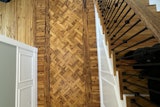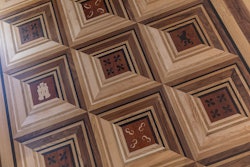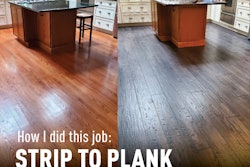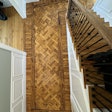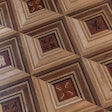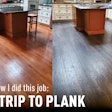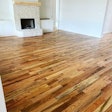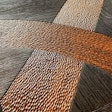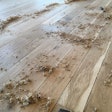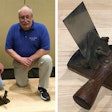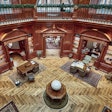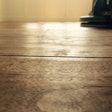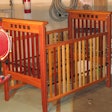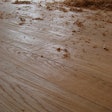
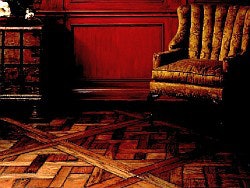
In most cases, if you walked onto a jobsite with newly installed hardwood floors and started hurling around axes, chains and saw blades, it would be the last thing you did—before the flooring contractor turned you into a human inlay on the floor. If the contractor were distressing the floor, however, he might ask you to join his crew. While making burn marks, gouges and holes in the floor normally would make a contractor spout a few choice expletives, many distressed flooring craftsman would consider these violent acts methods of adding character to the floor.
Hand-scraped and hand-distressed floors are gaining popularity throughout the country. Though hand-scraping floors is one of the oldest ways to sand a floor, it fell out of vogue when modern sanding and finishing techniques were invented and smooth, shiny floors were the standard. In recent years, distressed floors have seen a resurgence in California and other pockets of the country. More decorators are specifying distressed floors as a way to make a new floor look like it's 100 years old, and to give the floor a rustic, casual feel. Distressing also is a way to match antiqued cabinets and furniture.
The natural scratches and gouges in a distressed floor make it a perfect choice for homeowners who don't want to cringe every time their kids or pets leave a mark on the floor. There's also a certain amount of prestige for the homeowner to have a custom, hand-scraped floor. Distressed floors also are becoming popular in commercial applications such as restaurants, retail stores and museums, because they add personality to the room yet withstand high traffic.
Contractors who master the art of hand-distressing floors not only have more options to offer customers, they can charge a premium for their work. Distressing is not for everyone, however—it's a labor-intensive process that requires a high degree of skill and artistry.
The Art of Distress
While it may seem easy enough to beat the floor with various tools and other objects, hand-distressing floors is a true art form, involving much more than just hacking up a floor. The masters in the trade have spent years experimenting with different tools, perfecting their techniques and developing their own sense of style. The best craftsmen are artists who are passionate about their work and constantly are looking for inspiration on ways to add character to the floor.
Experts suggest that one of the best ways to get ideas for distressing a floor is to look at how wood and nature react over time. Find a historic building with wood floors to see how they have worn. Go to flea markets and check out old furniture. Look at old wooden buildings such as barns and sheds. Study the lines and contours of the wood grain and see how it wears and ages. Study trees and timber to see how bug and worm holes are formed. The more details you notice, the more realistic and creative the floor will be.
Creating the Look
The flooring craftsman creates the distinctive features of a distressed floor by hand—he doesn't use machines, and he turns each floor into an original masterpiece. There is no standard technique or tool used to create these floors, but there are many tricks-of-the-trade that professionals in the industry use.
Most contractors start by hand-scraping the floor, either on-site after the floor is installed or off-site before installation. Hand-scraping is a labor-intensive, tedious process, but it gives the most control over the look of the floor. Scrape with the grain, following the grain pattern and avoiding the knots. Adjusting the angle at which you scrape, the pressure you use and the sharpness of the blade all change the look of the floor. Depending on your technique, you can either tear the grain or burnish the floor, creating either a rough or a smooth look and feel. Some contractors also make their own custom blades to create different looks.
Because hand-scraping is an individual process, no two contractors scrape the floor the same way. That means if you have several employees working on a large floor and they all stay in the same area, you'll be able to notice the differences in the floor. Crews need to alternate the boards they scrape and move around the floor to keep it looking consistent.
It's also helpful to know which floors scrape better than others. Walnut, oak,hickory/pecan and pine are common species that adapt well to hand-distressing and scraping. Harder species such as teak, maple and some exotics are difficult to scrape and don't lend themselves to the worn, antiqued look. Always try a sample before attempting to distress species you haven't used previously.
Adding Character
Scraping the floor sets the initial tone of the floor, but using other tools and techniques is what gives the floor its personality. This is where the contractor turns into an artist. Wire brushes further add texture. Chains, hammers, chisels, awls and saw blades are just some of the tools used to create dents and cracks on the wood. Drills, ice picks and wire are used to create worm hole effects. Some contractors hammer nuts and bolts into the floor or pour liquid metal to create a bullet-hole effect. The possibilities are endless. Even a broken beer bottle has been used on a floor to create a crystallized effect.
Another popular effect is to add burn marks to the floor. Ways this look can be achieved include using a soldering iron, heated nuts and bolts or lacquer thinner. Obviously, extreme caution should be used with this technique.
After the character marks are made, many contractors accentuate them by adding black wood filler, resin, acid, inks or dyes. Resin in the knot holes gives the appearance of sap. Applying dark stain traps the color in the nooks and crannies of the floor. Some contractors apply several colors to the floor and randomly scrape them off to give the floor an antiqued look.
The best techniques are created by research and development. Experimenton pieces of wood and test floors. Go to the hardware store or look to other trades to find unconventional tools that can add character to the floor. The more time you put into creating your own style and signature mark, the more valuable you'll be to the customer.
Know your Worth
Hand-distressed floors require a great deal of skill, artistry, time and labor. It's a physically demanding job that takes a lot of time.
Hand-scraping and distressing are labor-intensive, and even the most efficient and physically fit contractor is doing well by creating 150 feet of distressed flooring a day on the job site. You need to bid the job accordingly and charge a premium for your time and effort. Estimate the hours and manpower it will take not only to create the actual floor, but also to assemble samples. If you're going to scrape the floors off-site, you need to charge for the actual number of feet you'll be scraping—far more than you'll be installing. Many contractors are intimidated by the huge number in the estimate, but sit down with the client and explain the charges. If the customer doesn't have the money to do a hand-distressed floor, suggest a factory distressed floor. It's better to turn down a job than to end up losing money on the job.
Inform the Customer
It's best to involve the client in every step of the process. Sit down with the homeowners and find out exactly how they want the floor to look. Distressing is subjective and can be interpreted myriad ways. Present several options, make samples, and have the client sign off on them before you start work on the floor. Having the homeowners there while you make samples not only will help you pinpoint what look they're trying to achieve, it also will show them how much work isinvolved. Also inform them that distressed work is permanent—no amount of sanding or buffing will get those marks out of the floor. That's why it's important to agree and sign off on the final design.
Before you start using every tool in your shed on your customer's floor, however, know your boundaries. Take the time to practice and learn the tricks of the trade from craftsmen who are experienced in distressing floors. Use industry contacts, such as the instructors at NWFA's Advanced School, to find a mentor willing to get you started. Once you learn the basics, you can create your own style and increase your value as a wood flooring craftsman.









